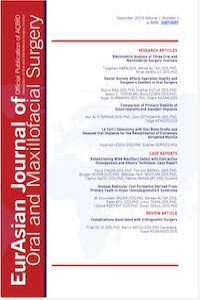Rehabilitating Wide Maxillary Defect with Distraction Osteogenesis and Khoury Technique: Case Report
Rehabilitating Wide Maxillary Defect with Distraction Osteogenesis and Khoury Technique: Case Report
Distraction osteogenesis, Khoury technique, maxillary defect, maxillectomy,
___
- 1. Sowerwine KJ, Holland SM, Freeman AF. Hyper-IgE syndrome update. Ann N Y Acad Sci. 2012;1250:25.
- 2. Davis SD, Schaller J, Wedgwood RJ. Job’s syndrome: recurrent, “cold”, staphylococcal abscesses. Lancet 1966;1:1013- 15.
- 3. Grimbacher B, Holland SM, Gallin JI, et al: Hyper-IgE syndrome with recurrent infections—An autosomal dominant multisystem disorder. N Engl J Med. 1999;340:692.
- 4. DeWitt CA, Bishop AB, Buescher LS, et al: Hyperimmunoglobulin E syndrome: Two cases and a review of the literature. J Am Acad Dermatol. 2006;54:855.
- 5. Freeman AF, Domingo DL, Holland SM. Hyper IgE (Job’s) syndrome: A primary deficiency with oral manifestations. Oral Dis. 2009;15:2.
- 6. Donabedian H, Gallin, JI. The hyperimmunoglobulin E recurrent- infection (Job’s) syndrome: A review of the NIH experience and the literature. Medicine.1983;62:195.
- 7. Shyur SD, Hill HR: Job’s syndrome of hyperimmunoglobulin E and recurrent infections, in Lichtenstein LM, Fauci AS, (eds). Current Therapy in Allergy, Immunology, and Rheumatology. St Louis, MO: Mosby-Year Book, 1992. p 322
- 8. O’Connell AC, Puck JM, Grimbacher B, et al. Delayed eruption of permanent teeth in hyperimmunoglobulinemia E recurrent infection syndrome. Oral Surg Oral Med Oral Pathol Oral Radiol Endod. 2000;89:177-85.
- 9. Domingo DL, Freeman AF, Davis J, et al. Novel intraoral phenotypes in hyperimmunoglobulin E syndrome. Oral Dis. 2008;14:73-81.
- 10. Mass E, Kaplan I, Hirshberg A. A clinical and histopathological study of radicular cysts associated with primary molars. J Oral Pathol Med. 1995; 24(10):458–61
- 11. Shetty S, Angadi PV, Rekha K. Radicular cyst in deciduous maxillary molars: a rarity. Head Neck Pathol. 2010;4(1):27– 30.
- 12. Nair PN. New perspectives on radicular cysts: do they heal?. Int Endod J. 1998;31(3):155–60.
- 13. Nagata T, Nomura J, Matsumura Y, Yanase S, Fujii T, Oka T, et al. Radicular cyst in a deciduous tooth: a case report and review of literature. J Dent Child. 2008;75:80–4.
- 14. Behrman RE, Kliegman RM, Jenson HB: Nelson Textbook of Pediatrics. Philadelphia, PA, Saunders, 2000
- 15. Burg FD, Ingelfinger JR, Wald ER, et al. Gellis and Kagan’s Current Pediatric Therapy. Philadelphia, PA, Saunders, 1999
- 16. Vigliante CE, Costello BJ, Quinn PD. Life- Threatening Cervicofacial Infection in a Child With Hyperimmunoglobulin-E Syndrome. J Oral Maxillofac Surg. 2001;59:561-565
- Başlangıç: 2020
- Yayıncı: Ağız ve Çene Yüz Cerrahisi Birliği Derneği
Dental Anxiety Affects Operation Quality and Surgeon’s Comfort in Oral Surgery
Burcu BAŞ, Nükhet KÜTÜK, Aysun ÇAĞLAR TORUN, Bora ÖZDEN, Vugar GURBANOV, Dilara KAZAN
Unusual Radicular Cyst Formation Derived From Primary Teeth in Hyper Immunoglobulin E Syndrome
Mustafa Ercüment ÖNDER, Berkan ALTAY, Fethi ATIL, Umut TEKİN, Doruk KOÇYİĞİT, Özkan ÖZGÜL
Rehabilitating Wide Maxillary Defect with Distraction Osteogenesis and Khoury Technique: Case Report
Yavuz FINDIK, Timuçin BAYKUL, Gülperi KOÇER, Mehmet Fatih ŞENTÜRK, Tayfun YAZICI, Halime KARAKURT
Complications Associated With Orthognathic Surgery
Bibliometric Analysis of Three Oral and Maxillofacial Surgery Journals
Comparison of Primary Stability of Sinus Implants and Standart Implants
